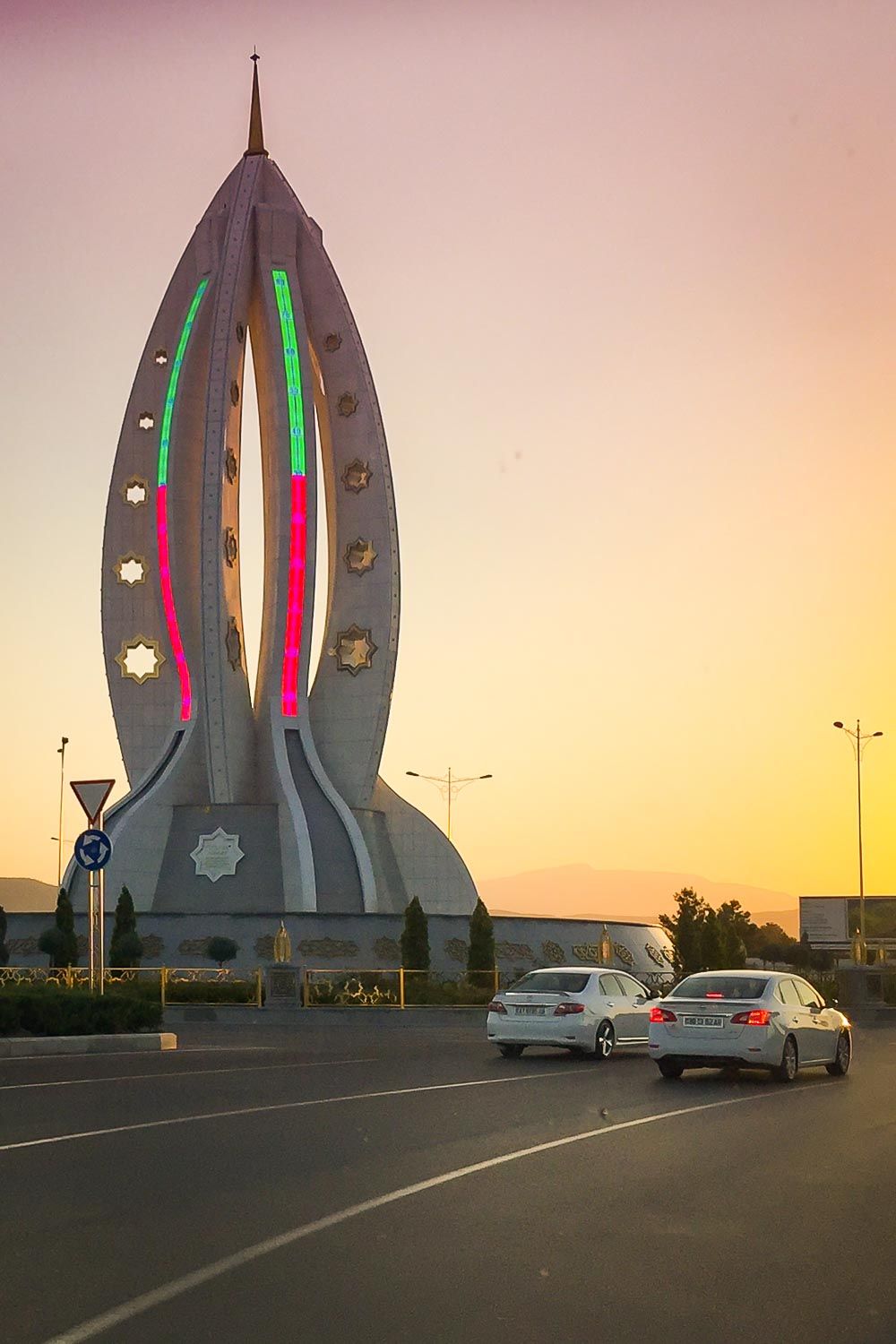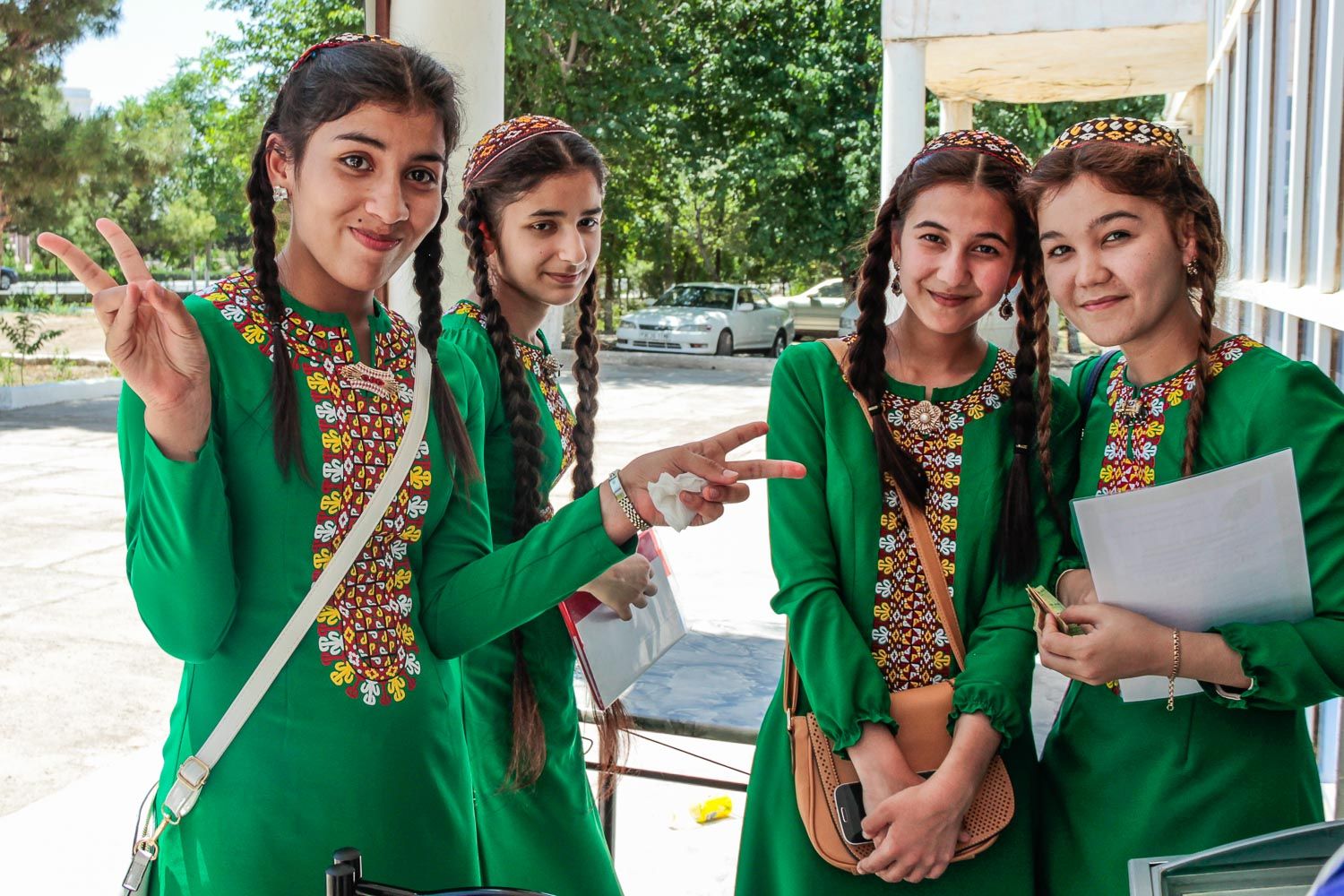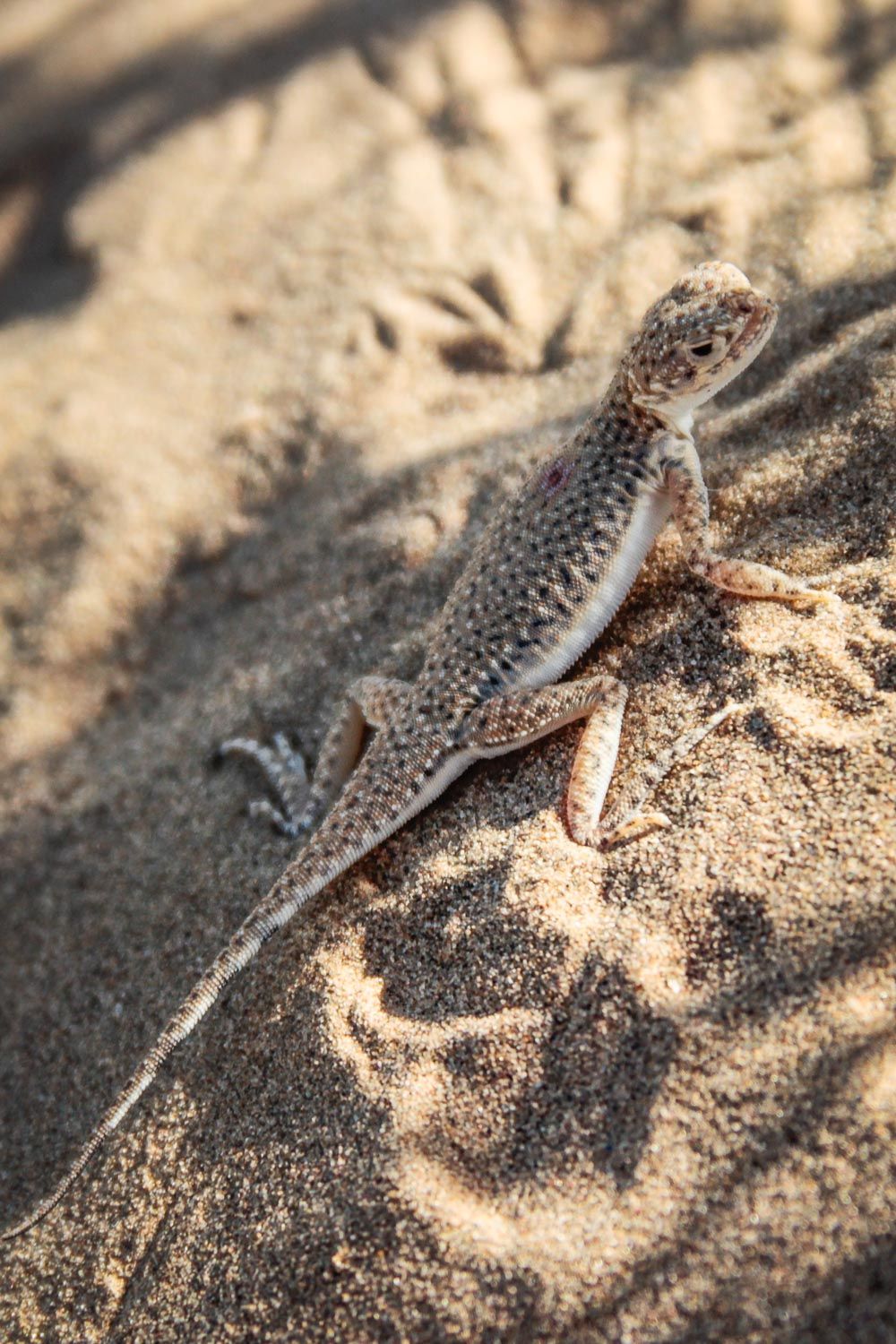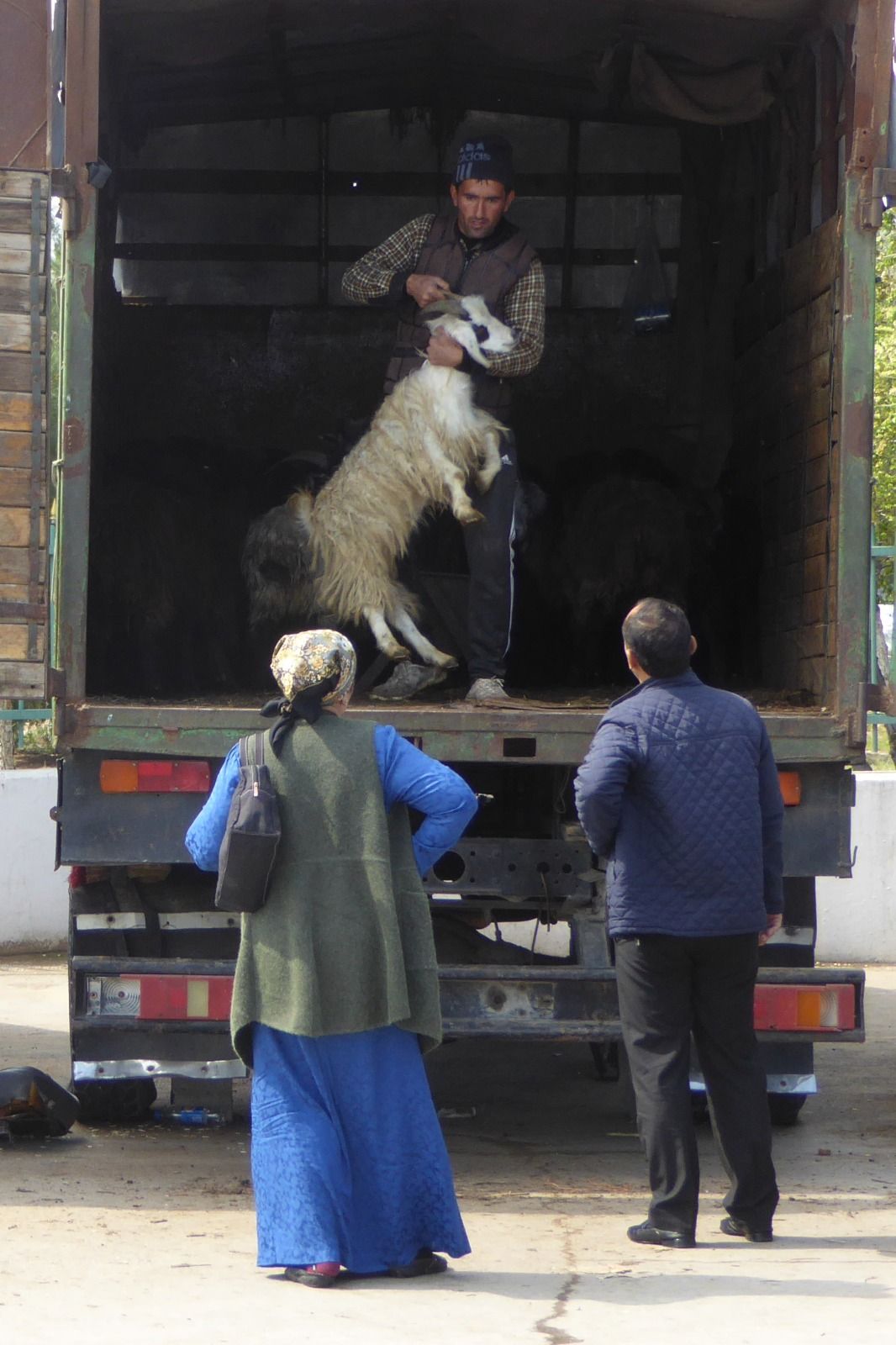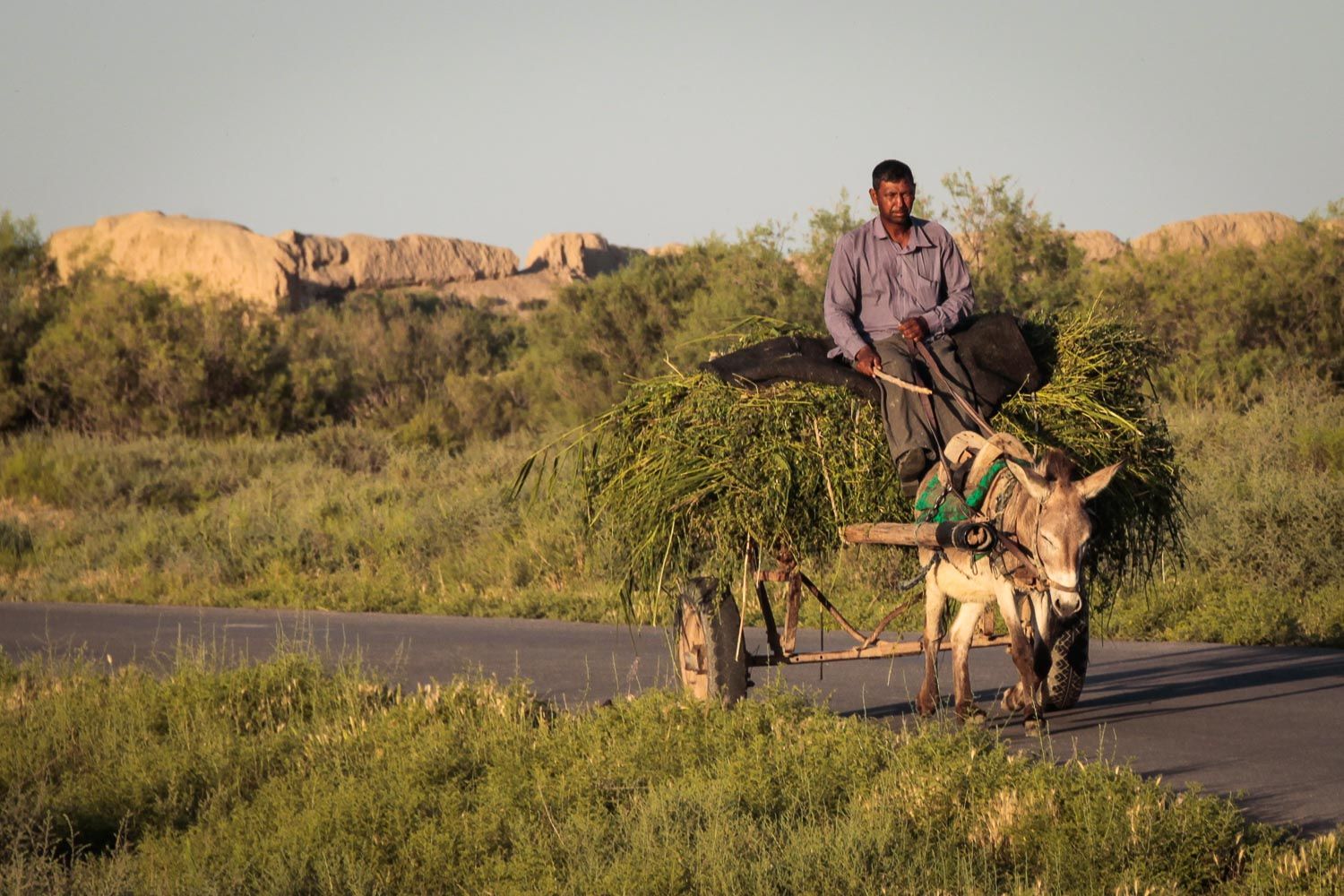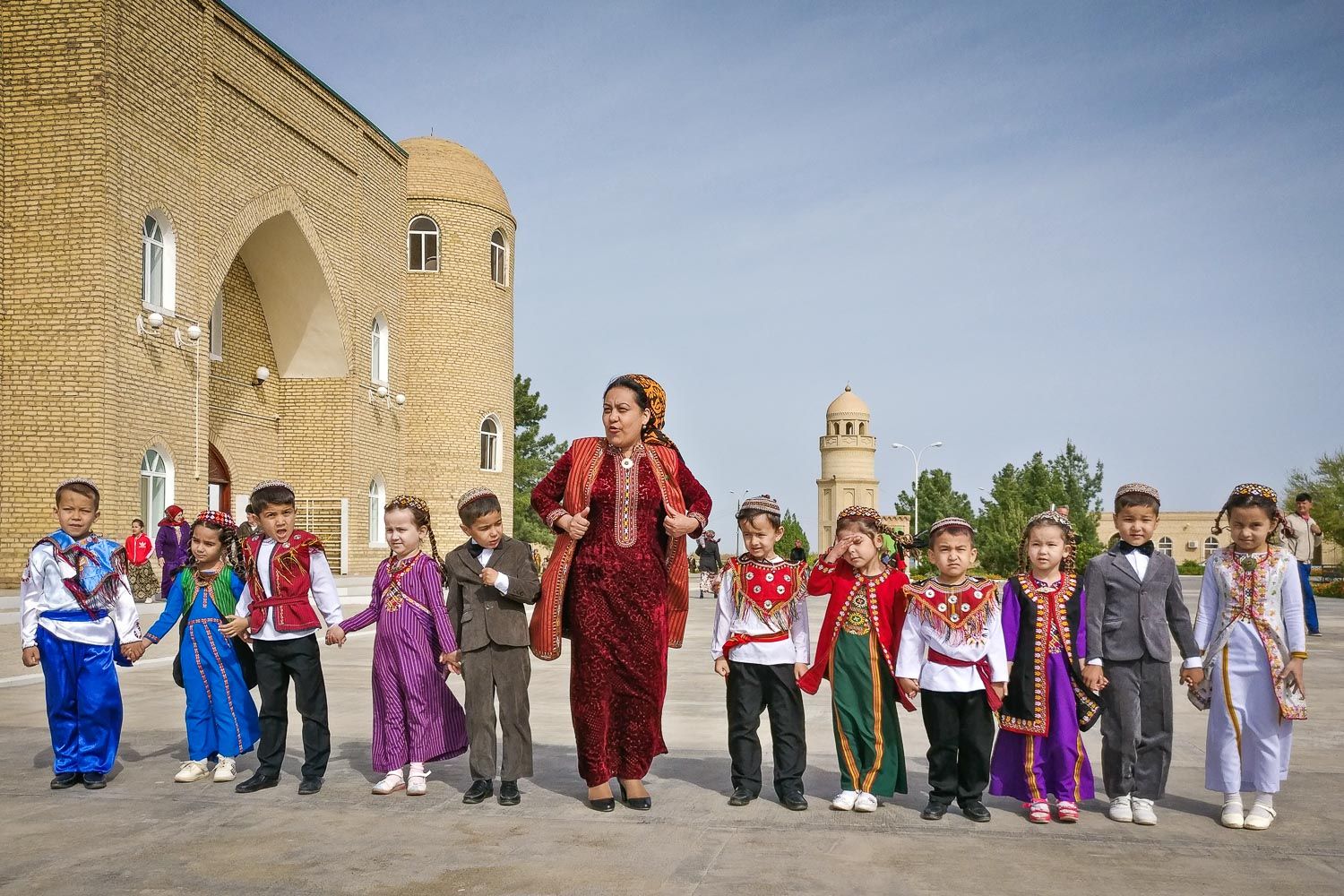Oasis of marble and gold
Turkmenistan
In Turkmenistan, one of the least visited countries in the world, immaculate gold and marble monuments arise from desert sands. But, the endless void of the Karakum Desert is like a treasure chest filled to the brim. Let us take you along the ancient Silk Road, past polychrome ravines, journeys back into time, captivating light shows and endlessly burning gas craters.
“Are you tourists?” asks the woman who introduces herself as Merjen. “We love tourists in my country!”

A Turkmen woman in a beautifully decorated deep red dress curiously approaches us while we wait for our luggage. “Are you tourists?” the woman asks, introducing herself as Merjen. “We love tourists in my country!” What a welcome you get when you are one of the few. Turkmenistan – wedged between the Caspian Sea to the west, Kazakhstan and Uzbekistan to the north, and Afghanistan and Iran to the south – is visited by less than 10,000 tourists per year. With its rich history, three UNESCO World Heritage Sites and the thrilling attractions of the Karakum Desert, it’s hardly surprising that the country is attracting more and more curious travellers.
Outside the terminal building, I immediately notice Ashgabat is a spotless, well-maintained capital. Nobody smokes in public, no billboards are marring the streetscape, and there’s not a single vehicle in need of a car wash. Frankly, with my long hair, I’m the only one standing out a bit. Two girls giggle and ask if they can touch it, to check if it is real.

This will make your head spin: go for a ride in the world’s largest indoor Ferris wheel
ASH VEGAS
Life is tough when sandy deserts cover four-fifths of your country. “The Karakum is also known as the Impenetrable Desert,” our guide Maksat explains. “Out of each twenty water springs, only one contains potable water. Hostile tribes from the north never dared to cross the Karakum. And when raids came from the south, Turkmen tribes lured their attackers into the desert. While the Karakum was a haven for us; enemies would never get out alive. In such a harsh environment, a drop of water is worth as much as a grain of gold. And a sweet watermelon is just priceless.”
In the light of all this, it’s understandable that Turkmenistan celebrates Melon Day each summer; that Ashgabat bus shelters are air-conditioned – temperatures exceeding 50°C are no exception in the capital city. “In Turkmenistan, we’ve got warm weather for nine months a year. The other three months, it gets incredibly hot,” Maksat notes, with humour as dry as the climate.
“Turkmen tribes lured their attackers into the desert. While the Karakum was a haven for us, enemies would never get out alive”
While driving around at daytime is already an amazing experience; things get even better at night. From a viewpoint high above the city, we see Ashgabat turn into Ash Vegas. The immense canvas of white marble – with a total surface of 4.5 million square meters – is playfully covered by flickering and dancing lights in every imaginable colour. We enjoy the endless light show until our eyes can take no more. We retreat for the night to Hotel Bagt Köşgi with its glistening glass orb, fixed on a marble eight-pointed star. The desert wind gently blows drops of water from the nearby fountains into my face, proving I’m not dreaming.

CARPET FULL OF PLOV
At a meditative pace, our train travels throughout the night, crossing the vast emptiness towards the port city of Turkmenbashi. Avaza, a popular resort on the Caspian Sea, is only a short bus ride away, but we continue our trip inland. A lonesome road leads into the rock desert surrounding the Yangykala Canyons. Yellow ground squirrels stretch their necks and follow our movements from the dusty roadside. Road signs warn of sand storms in an area where even camels only stray when they’re lost.
Once, this was the location of the immeasurable Tethys Ocean, until forty million years ago the Arabian tectonic plate collided with Eurasia. The Tethys Ocean was closed off and nowadays, only the Black Sea, the Caspian Sea and the Aral Sea remain. The rock formations and sharp ridges rising from the dried-up ocean floor seem otherworldly; a craggy and polychrome Martian landscape lined with white, orange, pink and red stripes.
Our way back to Turkmenbashi leads past Gözli Ata, one of the most remote pilgrimage sites in Turkmenistan. Two sober green cupolas adorn a brick tomb, with low walls protecting the nearby graves from the desert sand. A colourful collection of prayer rags is tied to the wooden poles emerging from the graves. Pink and white hills lovingly protect this sacred site, where welcoming pilgrims invite us to have lunch with them. Plate by plate, the carpet in the guest area is filled with fresh Caspian fish plov and flat chorek bread.
Experience Turkmen Hospitality
TASTE THE FLAVOURS OF AUTHENTIC TURKMEN
Golden sands of the Karakums and emerald waters of the Caspian, moon-like craters and martian canyons, dust covered ancient ruins and futuristic urban landscapes, inimitable culture deeply rooted in superstitions of the nomadic past and genuine hospitality. Turkmenistan is waiting to share its treasures, and so is the team of Ayan Travel. For over 20 years, they have been developing an array of adventures in the most spectacular natural areas of Turkmenistan. Their goal is still the same: to let you taste the flavours of authentic Turkmen.
A STAN-NING EXPERIENCE AWAITS
Home to some spectacular UNESCO-heritage sites, majestic architectural monuments and a number of dazzling natural wonders such as the Darvaza crater, Turkmenistan certainly deserves a spot on any adventurer’s bucket list. While 70% of the country is covered by desert, its historical heritage, fascinating traditions and welcoming people are everything but arid. Ashgabat-based DN Tours has a consolidated reputation in organizing tours for individual, group and business travelers who wish to plunge into Turkmenistan’s unique charm. Travel to Turkmenistan is an unforgettable experience.
GATES TO HELL
Again, the desert sands surround us. For hours, we drive across the Karakum to the burning gas crater of Derweze. Few countries have larger natural gas reserves than Turkmenistan, one of the fastest-growing economies worldwide. In 1971, Soviet geologists in search of oil came across a huge gas-filled cavern in the middle of the desert. When their drilling installation collapsed, the engineers lit the gas, hoping this would prevent toxic subterranean fumes from escaping. They estimated the gas would burn up within a couple of days.
Furious flames and a roar like that of a thousand Bunsen burners, burning simultaneously to hypnotize us
Well, it didn’t. Almost fifty years later, the fire still burns unabated. The scorching heat close to the ridge of the seventy-meter wide crater is outrageous. Furious flames and a roar like that of a thousand Bunsen burners, burning simultaneously to hypnotize us. Even without the pungent sulfur scent that rises from the depths, it requires little fantasy to imagine a gateway to hell in this never-ending inferno.
In the meantime, our guide Döwlet prepares the yurt close to the crater for a night in the desert. Geckos run away and hide under the canvas. I hope they will keep the scorpions and camel spiders at bay tonight. It’s time to put on our warm telpeks – large sheepskin hats. The heat of the fire on which Döwlet prepares our shashlik is not sufficient to counter the chill of the desert night.
CITY OF MUD
It’s hard to fathom this inhospitable landscape of dunes and gnarly saxaul shrubs was once home to one of the world’s largest cities. In fact, Merv might have been the largest city on earth, according to Tertius Chandler – a historian, specializing in population estimates of ancient cities. The city housed 200,000 to 500,000 inhabitants – extraordinary numbers back in the 12th and 13th centuries AD. Some historians even suggest it might have been up to a million.

Today, the oasis city is deserted. Merv was a so-called ‘wandering city’. In regular cities, new buildings are being built on top of older layers. Here, as water-courses shifted, the city had to be moved in its entirety several times. This resulted in five separate but adjacent cities – just the oldest three of them already covering an area of over a thousand hectares. Our tour of ten kilometres through unimaginably large Merv is, therefore, a journey back in time, starting at the almost thirty meters high walls of Erk Kala, the city founded by the Achaemenids in the 3rd century BC.
We once again find ourselves in a marvellous marble and gold building, dancing on the equally familiar tunes of 2 Unlimited with the Turkmen wedding guests
Merv is a UNESCO World Heritage Site and the most important archaeological site in the country. Once upon a time, the shimmering of turquoise tiles covering the 36 meters high Sultan Sanjar mausoleum could be seen by desert caravans still a day’s ride away from the city. Today, the dome is entirely sand-coloured. The glazed tiles that are omnipresent in the Silk Road cities of Uzbekistan are a rare sight in Turkmenistan – although archaeologists are busy restoring historic buildings. That’s a good thing, as the unforgiving desert climate has taken its toll on the mud walls of many fortresses, mausoleums and ice houses.
In front of the arched entrance gate of the Sultan Sanjar mausoleum, women in delicate traditional dresses, ranging from emerald green to crimson red, pose for a family portrait. Just like at Ashgabat airport, foreigners are as rare a sight as the long lost turquoise faience tiles. It’s not long before we are invited to a wedding in the nearby town of Mary. And so, on our last night in Turkmenistan, we once again find ourselves in a marvellous marble and gold building, dancing on the equally familiar tunes of 2 Unlimited with the Turkmen wedding guests.

Do & See in Turkmenistan










